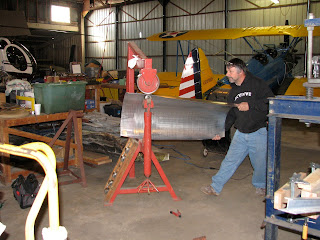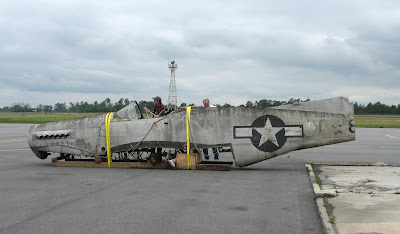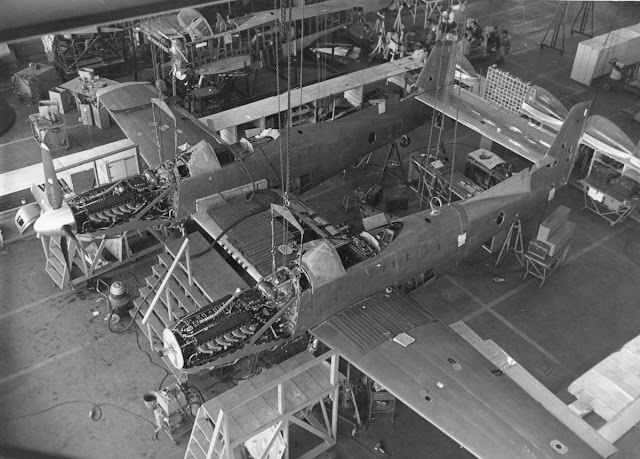“XP-82 Restoration Project”
#44 83887 Twin Mustang Progress Report
Work Progress
2010 was an extremely good year for progress on your XP project. Reading through our past news releases that we are going to post on our web site, I am amazed by what our crew completed through 2010: horizontal stabilizer, elevator, center section flap, left-hand fuselage less belly scoop areas, most of two aft fuselage extensions, both verticals, half of the right-hand fuselage, engine mounts, center section spar caps, webs, skins, amd 50% of the four ailerons and rudders. MT Propeller had a successful test flight with the new blades and, our second engine, the right hand turner, is going into final assembly ... and the list goes on and on with all the small parts.
A very good year indeed and my sincere thanks to every team member who is making this XP-82 dream come true.
Center section fixture |
Randall and Jeremy completed our center section fixture. When our center section spar caps arrive this February, we can start assembly of the center section. Pat (Anoka, MN) graciously offered to lend us his fixture, but his center section will not have been off his fixture until spring/summer, and we need to start before then. Thank you, Pat and Jim. Thank you to Carlin Thomas with Horton Iron Works in Eatonton, GA, for the very good price on the steel for the fixture and the water-jetted side plate patterns for the center section.
 |
| Right-hand forward fuselage |
 |
| Right-hand aft fuselage |
 |
| Two scoops and dog houses |
Our latest investor helped out for a few days on this scoop and dog house work. Thanks. Also, three of our original investors came from Florida and Savannah last week and helped out. All of this help is much appreciated by all of the work crew here in Douglas.
The Big Push This Year
• Complete both fuselages, mount on a rotisserie and complete both belly scoop and dog house assemblies.
• Complete the center section, fit and mount both fuselages.
• Align the aft fuselage extensions, verticals and horizontal. Complete the
aft attachment bulkhead and permanently attach to forward fuselages.
• Install the main landing gear in the center section.
• Attach the engine mounts to the firewalls.
It’s a significant list, but this is what we are going to shoot for.
Anoka F-82
With the amount of completion that Pat Harker and his team have accomplished on their F-82 (their work is breathtaking), they possibly will have a first flight late this year or early next. Good luck to Pat and his team.
Work Force
Good news. Bryan, our team member who had to return to Augusta last fall is now back with us. A first-class sheet metal bender, he just couldn’t stand working in the corporate environment any longer, and had to come back and work on our unique warbird again.
 |
| "English wheel Casey" |
Casey, English wheel wizard from Atlanta, came down and completed some more top skins for the RH fuselage for us.
Due to catching the crud that everyone in Georgia has had, I didn’t make it to California this past month. I no longer need to go at this time, so we saved the airline ticket cost and expenses.
Publicity
During the fall of this year, we had a few articles come out in Warbirds International, Air Classics and AOPA E-Pilot that really didn’t tell the entire story of our XP project. On the 11 of January, I decided to take some time to sit down and write an article on the complete story of the XP purchase and restoration. After a day or so and with many adjustments by Nan (Weezie’s English professor sister), we had an article that was released to all aviation media outlets. The article that EAA News immediately published and the interest and comments generated by this story as it went viral on the Internet have been phenomenal.
I got the idea to write a story because I was concerned about a possible impression that our project could not be completed due to lack of parts, especially engines and a LH prop. I feel now that, with the tens of thousands of aviation enthusiasts who have read the article, that is it now obvious that our XP project will definitely be completed and flown.
Speaking of flying, Mike Brooks found a short 20 second video showing our XP on its maiden flight. ( http://www.youtube.com/watch?v=qAd6t_On4rQ ) Unless the frequency of the camera and the prop rotation on the shot of the 82 taxiing out confuses the prop rotation, (do you remember the wagon wheels in the old westerns going backwards?), it shows clearly the props at idle turning outboard.
 |
| Our XP-82 on her first flight |
As in the past, there are questions as to which XP-82 flew first--44-83886 or ours 44-83887. Air Force records show 886 flying first, but there is not one picture of 886 flying. There are countless pictures of our 887 flying on its first flight with the props turning outward. One can look at the in-flight blade profiles and tell which way the blades are turning. North American Aviation records speak extensively of the props turning outwards -- “the wrong way” on the first and only test flight on 15 April 45, and then almost losing the USAAF contract to continue the XP program until the improper flying characteristics of the first flight were corrected. Some North American engineer after 6 to 8 weeks of head scratching suggested to swap firewall forwards and the rest is history. Every flight after the first prototype flight of 887 (ours) shows the props were inward turning. The first pictures definitely prove which flew first--our 44-83887.
Web site
The web site set up is coming along well. Lots of set up work, but we think it will be up and running by the time you received this news release. Many thanks to Donna (daughter), Weezie and Jen Renninger, the step daughter of one of our investors.
Bumps in the Road
None, other than spending close to the national debt this past month on an engine payment, righthand engine top cowls and spar machine shop charges. Other than that everything else is going well.
“Do you want to know a secret” Rivet asks Allison.
Allison in the belly scoop, “Be sure to wake me up before you start skinning the inside, so you don’t close me up in here.”
 |
| "Be sure to wake me ...." |
Please come and see your XP project. Pictures do not do it justice. Bring your work clothes!
Thankx.
Tom
Sad News
Bobby Leary, previous owner of my B-25 Killer B died on 23 January from cancer. He was 52 years old and an ardent warbird supporter and a trooper up to the end.
God Speed, Bobby.






















